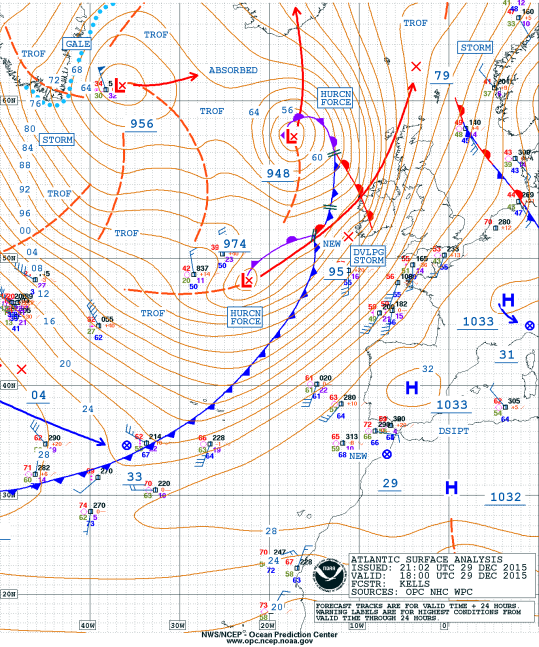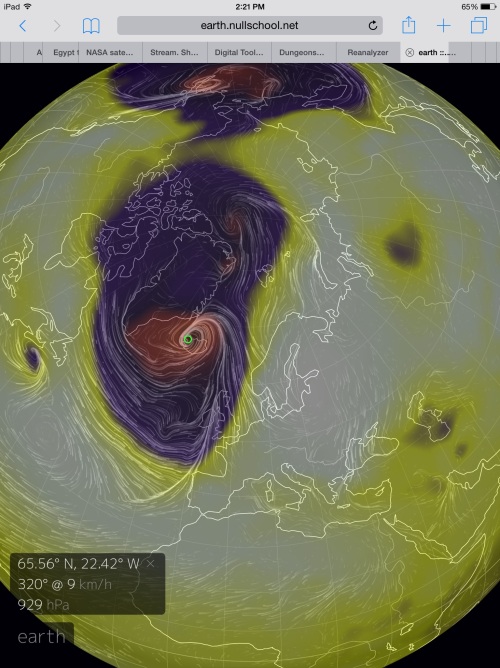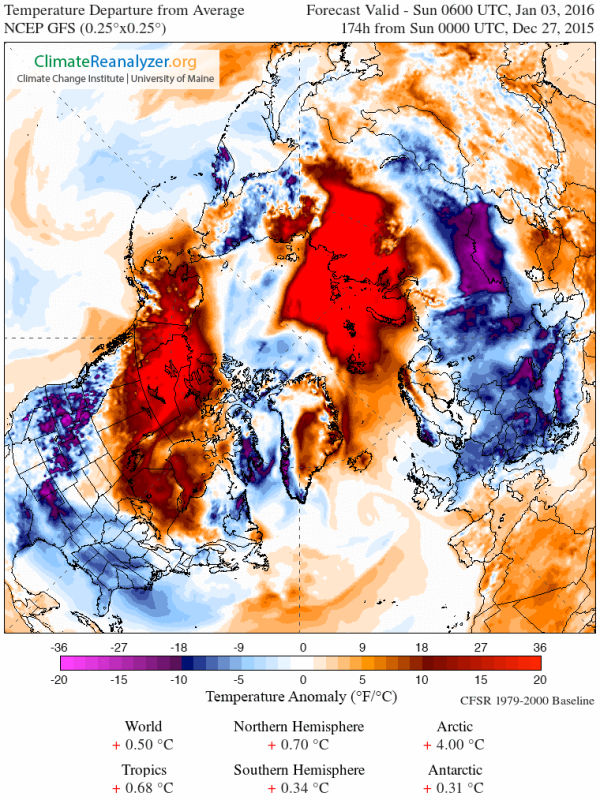Andy Lee Robinson said it all-too-well — “El Nino + Climate Change = El Diablo.”
And as the Washington Post so cogently notes — the world is now experiencing a rash of Freakish Weather from the North Pole to South America. It’s what appears to be happening as these two major record weather makers fire off simultaneously. A grim tally that includes the highest river levels ever seen in Missouri, the worst floods England has seen since the Middle Ages, the first time the North Pole has seen significantly above freezing temperatures during Winter in modern record keeping, city and region-crippling droughts spanning Central and South America, and seemingly everywhere, but especially in the North Atlantic where Greenland melt outflow has backed up the Gulf Stream, storms that seem to laugh in the face of our weather history.
(Extreme weather on both sides of the North Atlantic on December 29, 2015. In upper right of frame, the daisy chain of lows named Frank bears down on Iceland and the UK. Meanwhile, a severe storm dumps flooding rains over the Central US. Image source: LANCE-MODIS.)
Dr. Jeff Masters, at Weather Underground, yesterday made this grim observation:
“This isn’t the climate I grew up with. We didn’t see this kind of weather in the 20th century. It’s just a continuation of the crazy weather we’ve seen over the course of the 21st century so far.”
Attributing Single Extreme Weather Events to Climate Change
But Dr. Masters will be the first to tell you that it’s tough to scientifically prove that any one storm or weather system was altered by climate change. In essence, it’s like trying to prove that this home-run or that shut-out was caused by a baseball player taking steroids. We know that the steroids result in a changed performance by the athlete, just as we know that climate change alters the overall performance of weather. But it’s devilishly difficult for scientists to pin down the exact climate change mechanisms going into this or that monster storm or mega-drought. It doesn’t mean that climate change or steroids aren’t at work, because they are. It’s just hard to pin down exactly when.
It’s this gray area that climate change deniers and fossil fuel backers have exploited to generate doubt that climate change is happening at all. They’ve hyper-focused on this storm or that drought, rather than the larger extreme weather and temperature trend — which is clearly changing and worsening. It’s almost as if a group of baseball fans got together to defend the use of steroids in the sport and placed the burden of proof on whether or not an individual home run was caused by the stuff. A false analysis that puts both scientists and those concerned about the environment into the ridiculous position of having to prove the existence of climate change in one storm or a single drought. The ludicrous assumption being that, otherwise, climate change doesn’t exist at all.
But merchant of doubters didn’t count on one thing — the advancement of science.
For truth be told, we are now starting to tease out a few of the direct influences of climate change on extreme weather events. One particularly powerful element being what is known as the heat-moisture engine. It’s well known that temperature differentials and rates of evaporation can have a significant influence on weather. And climate change itself fundamentally alters these aspects of weather by 1 — changing the rate of evaporation and precipitation on a global basis and 2 — putting hot and cold air and water masses in places where they’ve never been before.
(Sea surface temperature anomalies in the North Atlantic are just going bonkers. From the blazing hot back-up of the Gulf Stream off the US East Coast to the freakish cool pool related to increasing glacial melt just south of Greenland to the abnormally warm and ice-free Barents, sea surface temperature patterns in the North Atlantic have been consistently and radically changed by factors related to human-caused climate change. It’s a fearsome engine of extreme weather that’s only recently emerged. One that may as well have the words ‘human-forced warming’ etched across it in bold script for all to see. Image source: Earth Nullschool.)
Scientific luminary Dr. Kevin Trenberth noted in the New York Times today:
In both the Atlantic and Pacific, the unusually warm ocean surface is throwing extra moisture into the air… Storms over land can draw moisture from as far as 2,000 miles away, he said, so the warm ocean is likely influencing such events as the heavy rain in the Southeast, as well as the record number of strong hurricanes and typhoons that occurred this year in the Pacific basin, with devastating consequences for island nations like Vanuatu. “The warmth means there is more fuel for these weather systems to feed upon,” Dr. Trenberth said. “This is the sort of thing we will see more as we go decades into the future.”
North Atlantic Bombs Going Off The Charts
But it is in the North Atlantic that the influences of human-forced climate change upon the weather are starting grow most starkly clear. There the impact of El Nino is far less obvious. During a typical strong El Nino year, storms tend to form more-so over Iceland. And we’ve seen that. But in the past, El Nino years have also tended to bring colder weather to Scandinavia as the Northern Hemisphere Jet Stream strengthened and locked cold air into the higher Latitudes. However, this year, as in recent years, the Barents Sea has been freakishly warm. This region, which during the 20th Century featured much more sea ice than today, is now mostly ice free. And this broad section of open water vents heat into the atmosphere, warming Scandinavia and providing a weakness in the Jet Stream for warm air invasions of the Arctic.
This week, the warm slot over the Barents provided the pathway for a daisy chain of low pressure systems — ranging from the UK to Iceland to the High Arctic — to pull above-freezing temperatures all the way to the North Pole. It was an unprecedented event and one far less likely to have been strongly influenced by El Nino than by human-forced climate change.
Another feature in the North Atlantic related to climate change is a cool pool of water south of Greenland. This pool is generated by increasing glacial melt outflows from the warming and thawing mountains of ice covering that frozen isle. In juxtaposition to the warming Barents, this cool pool creates what in weather terms is called a dipole. A region of cold facing off against a region of hot. Dipoles are notorious for their potential to generate extreme weather. And the Barents/North Atlantic anomaly dipole is something entirely new. A weather system that aims a more heavily moisture laden Atlantic storm track directly at the United Kingdom. An island nation that this year is sitting directly in the path of a northward moving warm wind. A warm air and moisture flow that has all too frequently embedded monster rainstorms never before seen in the isles’ history.
Extreme Storm Was 40 Percent More Likely Due to Climate Change
Myles R. Allen, a Climate Scientist at the University of Oxford, finds warnings by weather and climate experts that instances of extreme weather would emerge due to human-forced warming are now made real:
“As scientists, it’s a little humbling that we’ve kind of been saying this for 20 years now, and it’s not until people notice daffodils coming out in December that they start to say, ‘Maybe they’re right.’ ”
Dr. Allen was the lead of a cutting edge scientific study that, earlier this month, used model runs to find that the recent spate of record UK floods was made 40 percent more likely by human-forced climate change. The study was spurred by a storm that dropped 13 inches of rain on a Northern England town in just 24 hours. It’s worth noting that a 40 percent increase in extreme weather potential isn’t just a little nudge of the needle, it represents what in scientific terms is known as a state change. In other words, if heating of the world’s climate system has made extreme storms 40 percent more likely in your country, then your climate is now nothing like it was before.
(It’s not just daffodils blooming in England. All over the western world flowers have been blooming out of season during the freakishly warm weather of Winter 2015. Above, the iconic cherry blossom blooms in my hometown of Gaithersburg, MD on December 31 of 2015. Photo credit: Robertscribbler.)
After the study, the UK was hit time-after-time-after-time by similar record flooding rains. One being the same system that drove temperatures at the North Pole to above freezing in Winter, flung rains over Arctic sea ice during the depths of polar night, and whose rains and winds again spurred raging floodwaters in North England that destroyed a beloved 300-year-old bridge. This isn’t just one instance. What we’re looking at here is the likelihood that England will continue to experience these kinds of freak storms on-and-on until at least March and probably through to April. And that’s just this year. For the pattern is so altered now that England appears to be facing an age of storms the likes of which it has never seen before.
The Climatic Disruptions Have Now Begun
Today The New York Times is calling it Climate Chaos, The Washington Post — Freakish Weather. But what we are really seeing is the start of the extreme climate disruption experts and scientists have been warning us about all along. A disruption resulting from a severe warming of the globe’s atmosphere, oceans, and ice. One that some tried to deny was happening at all but that is now, as likely as not, wreaking havok in their own hometowns. Given the dismal state of affairs, one has to honestly ask the question — why didn’t we listen? Why didn’t we act early to stop this horrendous mess? And following this question, an assertion — we would be insane to not work as hard as we can to prevent this abysmal situation from further worsening.
Links:
Freakish Weather From the North Pole to South America
Rivers Reach Never Before Seen Level in Missouri
Warm Storm Brings Rain Over Arctic Sea Ice in Winter
North Pole Hits Above Freezing Temperatures During Winter
Raging Floodwaters Destroy 300 Year Old Bridge in England
Hat Tip to Andy Lee Robinson
Hat Tip to TodaysGuestIs
Hat Tip to Suzanne


































